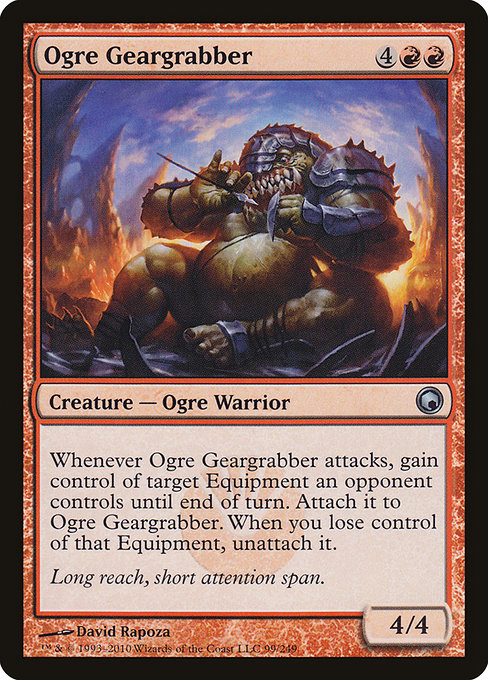
Image courtesy of Scryfall.com
A new lens on MTG design: meta-aware punch from Ogre Geargrabber
If you’ve ever marveled at how a single card can bend a whole game plan, you’re already part of the conversation about meta-aware design. Ogre Geargrabber, a red Scars of Mirrodin creature from the Mirran side of the artifact-heavy era, embodies a design philosophy that thinks not just about what a card does, but how it interacts with the board state and your opponent’s choices. A 6-mana threat with a surprising tempo swing, Geargrabber invites you to turn your opponent’s gear against them—at least for a turn or two. 🧙♂️🔥💎
Let’s break down what makes this uncommon red behemoth special. With a mana cost of {4}{R}{R} and a sturdy 4/4 body, it’s not your typical big-hitter for the early game. But the real juice lies in its attack-triggered ability: “Whenever this creature attacks, gain control of target Equipment an opponent controls until end of turn. Attach it to this creature. When you lose control of that Equipment, unattach it.” On the surface, it’s a straightforward tempo steal, yet the implications ripple through every combat step. You swing, you steal a sword or shield, you attach it to Ogre Geargrabber, and suddenly your opponent’s threat removal becomes a liability rather than a guaranteed trade. And if you manage to hang onto the Equipment or force a favorable exchange, the payoff compounds—your foe must re-equip, re-evaluate, and re-allocate resources. In a world of glowing artifacts and glittering swords, that’s a spicy meta move. ⚔️
Design-wise, Geargrabber sits squarely in the “play with the expected” camp, then subverts that expectancy just enough to create real pressure. It’s red through and through: aggressive, disruptive, and reactive. The fact that the effect is temporary keeps the line of play honest—your opponent isn’t out of the game for good if you steal a Gear, and you’re never guaranteed to lock down the board the moment you attack. The flavor text—“Long reach, short attention span.”—twists the mechanic into a quick, opportunistic joke about goblin-like opportunism and relentless tempo. It’s a card that rewards you for reading the opponent’s likely Equipment suites and for timing your attack to maximize the stolen gear’s impact. 🧙♂️🎲
From a meta-design perspective, Ogre Geargrabber is a study in how to embed interactivity with artifacts without creating a straight-up auras-and-equipment lockdown. The card’s rarity—uncommon—feels intentional: it’s powerful and memorable, but not so oppressive that it warps Limited or rotates into broken Constructed combos. And with Scars of Mirrodin’s watermark and artifact-forward flavor, Geargrabber slots into a broader narrative about corroded gear, the Mirran resolve, and a world where metal hums with magic. The design also mirrors a larger trend in MTG: giving red players tools that punish control-oriented artifacts while still leaving the game dynamic and fast-paced. The card is modern- and legacy-legal, a nod to players who love both history and the edge-of-seat moments that define high-level play. 🔥💎
Thinking about the future, meta-aware card design is likely to embrace even subtler board-state cues: cards that react not just to a single equipment, but to a bundle of ongoing effects, or to the tempo of an opponent’s curve. Ogre Geargrabber shows that designers can reward aggressive plays while weaving in strategic decision points—choices that become more interesting as the game evolves. In a world where digital tooling and data analytics increasingly inform set design, such cards offer a clear pathway: make the player anticipate the entire battlefield, not just the next draw step. The result is a MTG ecosystem that feels more interactive, more human, and slightly more playful—an intentional wink to players who love both the math and the mischief. 🧙♂️🎨
For fans who want to keep the fun traveling with them beyond the table, a handy gadget helps keep decks and dice within arm’s reach: the Phone Grip Click-On Mobile Holder Kickstand. It’s a compact way to keep your kit accessible during in-person events or impromptu kitchen-table tournaments—perfect for those who want to stay nimble while drafting or rumbling with red’s speed. If you’re picking up Ogre Geargrabber as a centerpiece artifact of your strategy, the gear you carry to the table should be as ready as your spells. ⚔️🧙♂️
Phone Grip Click-On Mobile Holder KickstandMore from our network
- https://blog.crypto-articles.xyz/blog/post/cosplay-meets-fairy-energy-themed-deck-builds/
- https://articles.digital-vault.xyz/blog/post/hollow-knight-players-react-to-boss-battles-and-lore/
- https://crypto-acolytes.xyz/blog/post/monetary-systems-in-open-world-games-how-economies-function/
- https://blog.rusty-articles.xyz/blog/post/corsolas-attack-and-tempo-in-scarlet-violet-tcg/
- https://blog.digital-vault.xyz/blog/post/kydele-chosen-of-kruphix-market-signals-before-major-reprints/